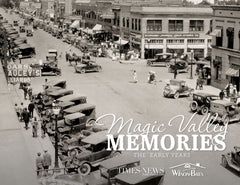Homesteading in Magic Valley
There were limited options for the first pioneers trying to build a home, a town, and a life in early Twin Falls. Many families went for years without having a proper place to hang their hat, but they never lost their spirit and made a home for themselves and their families wherever they were staying.
Some of the first homesteaders would use what they could of lumber and tenting material to build makeshift homes. Imagine what it must have been like to have all of your necessities of daily living kept outside.

Matthew and Martha Batty’s first home in Rock Creek Canyon, Twin Falls, 1905. Matthew is sitting down wearing a hat and Martha is leaning against the pole. Margaret Batty is in the back row, second from left.
Courtesy Debra Robinette
The Homestead Act of 1862 allowed homesteaders to legally own pieces of land if certain requirements were met within the span of five years.
Heads of household at least 21 years of age or older were eligible to file a claim at the local Land Office, at which point they'd have five years to build a house, farm the land, and then find neighbors to swear that all requirements were met. If all went well and they could pay the filing fee, the new homeowner would receive a patent for the land.

Ralph Eli Shotwell and Esther Shotwell riding in their Anatolian goat-powered wagon at Grandview Drive and Falls Avenue, Twin Falls, 1918. In the background is the family’s “prove-up” house the Shotwells built in order to satisfy homestead regulations. The Shotwells came from the Parma area in 1907.
Courtesy Kathy Williams
Another option for those looking for housing was to find a place that was letting out rooms. This was a temporary measure for most; they would stay as they were building their home, or as they were building their business to raise money for a home.

“The Homeless Twenty” in the home of R.M. McCollum, Twin Falls, 1905. As the town of Twin Falls was being built, housing was at a premium. Early Twin Falls entrepreneurs pictured here found themselves in need of housing and were taken in by Mrs. McCollum. These businessmen went on to create the Commercial Club.
Courtesy Twin Falls County Historical Society
Learn more about Magic Valley history and see hundreds more beautiful, historic photos in the Times-News new book, Magic Valley Memories.

$44.95